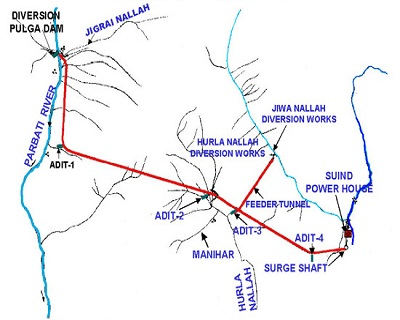




Disclaimer: Copyright infringement not intended.
Naini Lake in Uttarakhand has recorded critically low water levels due to declining rainfall, climate change & encroachments posing severe risks to water security & ecological balance.
Five Year Low Water Level Naini Lake water level has dropped to 4.7 feet lowest in five years sparking concerns over water availability.
Impact on Drinking Water The lake supplies 76% of Nainital drinking water & its depletion threatens city water security.
Climate Change Factor Rising temperatures & decreasing winter snowfall have accelerated lake water level decline.
Unregulated Urbanization Encroachments, unplanned construction & concrete structures around lake have reduced groundwater recharge capacity.
Pollution Issues Wastewater discharge, poor solid waste management & sewage overflow have degraded lake ecosystem.
Legal & Conservation Efforts Multiple legal petitions including Supreme Court & Uttarakhand High Court interventions have aimed at halting unchecked urban expansion but have had limited success.
Tourism vs Sustainability Increased tourism-related infrastructure is placing additional stress on lake affecting long term ecological balance.
Urgent Need for Conservation Experts emphasize restoring lake natural recharge zones & implementing an ecosystem based approach to rejuvenation.
|
Aspect |
Details |
|
Geographical Location |
Nainital, Uttarakhand, India |
|
Latitude & Longitude |
29.39°N, 79.46°E |
|
Origin |
Natural, tectonic depression |
|
Type |
Freshwater lake |
|
Shape |
Kidney-shaped |
|
Surrounding Features |
Bounded by seven hills: Ayarpata, Deopata, Handi Bandi, Cheena Peak, Alma, Laria Kanta & Sher-Ka-Danda |
|
Depth |
Maximum: 89 feet (27 meters) |
|
Length & Width |
Approx. 1.43 km long, 0.48 km wide |
|
Water Spread Area |
Approximately 48 hectares |
|
Catchment Area |
11.73 square km |
|
Gauge Level |
Normal: 12 feet |
|
Inflow Sources |
Rainfall, natural springs, surface runoff |
|
Outflow Channel |
Balia Nala an underground drainage system |
|
Hydrology |
Receives water from direct precipitation & surface runoff; primary outflow through seepage & controlled drainage |
|
Water Quality Issues |
Increasing pollution from sewage discharge, solid waste dumping & stormwater runoff |
|
Biodiversity |
Home to aquatic flora & fauna including fish species like Mahseer & Rohu |
|
Vegetation |
Surrounding hills have oak, pine & deodar forests |
|
Aquifer Recharge Source |
Sukhatal Lake seasonal lake acting as a major groundwater recharge zone |
|
Major Threats |
Encroachments, declining recharge capacity, deforestation, pollution, climate change impacts |
|
Climate Influence |
Reduced winter precipitation & rising temperatures affecting water levels |
|
Historical Significance |
British-era hill station development due to lake discovery in mid 19th century |
|
Tourism Impact |
Excessive boating, waste generation, increased water demand |
|
Urbanization Effect |
Expansion of homestays, hotels & commercial buildings reducing rainwater percolation |
|
Conservation Measures Taken |
Restrictions on construction, High Court interventions, public awareness campaigns |
|
Future Conservation Needs |
Sustainable urban planning, wastewater treatment, afforestation in catchment area |
|
Lake Name |
Location |
Type |
Significance |
|
Dal Lake |
Jammu & Kashmir |
Urban freshwater |
Famous for tourism & houseboats |
|
Wular Lake |
Jammu & Kashmir |
Freshwater |
Largest freshwater lake in India |
|
Chilika Lake |
Odisha |
Brackish water |
Largest coastal lagoon in India, famous for migratory birds |
|
Sambhar Lake |
Rajasthan |
Saltwater |
Largest inland salt lake in India |
|
Loktak Lake |
Manipur |
Freshwater |
Known for phumdis (floating vegetation), only floating national park (Keibul Lamjao) |
|
Vembanad Lake |
Kerala |
Brackish water |
Longest lake in India, vital for Kerala’s backwaters |
|
Pulicat Lake |
Andhra Pradesh/Tamil Nadu |
Brackish water |
Second-largest saltwater lake in India, important for flamingo migration |
|
Bhojtal (Upper Lake) |
Madhya Pradesh |
Freshwater |
Main water source for Bhopal |
|
Naini Lake |
Uttarakhand |
Freshwater |
Key tourist attraction, water source for Nainital |
|
Pangong Lake |
Ladakh |
Endorheic (Saltwater) |
Partially in India, extends into China |
|
Law/Policy |
Year |
Purpose |
|
Environment Protection Act |
1986 |
Regulates activities impacting water bodies, pollution control |
|
Water (Prevention & Control of Pollution) Act |
1974 |
Establishes guidelines for water pollution control & monitoring |
|
Groundwater (Regulation & Management) Act |
2017 |
Governs sustainable use of groundwater resources |
|
EIA (Environmental Impact Assessment) Notification |
2006 |
Requires environmental clearance for projects affecting water bodies |
|
National Water Policy |
2012 |
Advocates integrated water resource management, conservation |
|
State-specific Water Conservation Acts |
Varies |
Many states have laws protecting local lakes & groundwater |
|
Wetlands (Conservation & Management) Rules |
2017 |
Provides protection for lakes & wetland ecosystems |
|
Solid Waste Management Rules |
2016 |
Regulates waste disposal to prevent lake contamination |
|
Inter-State River Water Disputes Act |
1956 |
Addresses conflicts over water sharing between states |
For more such articles, please refer to IAS GYAN
Sources:
|
PRACTICE QUESTION Q. Discuss ecological & socio economic challenges faced by Naini Lake due to urbanization, climate change as well as tourism. Suggest sustainable measures for its conservation & long term water security? |











© 2025 iasgyan. All right reserved